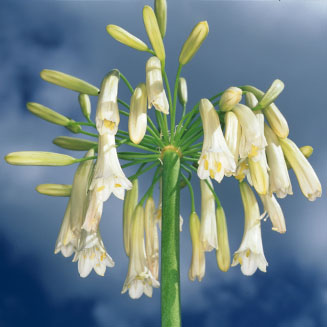Agapanthus inapertus (Drakensberg
agapanthus, Drooping agapanthus)
[= Agapanthus dyeri]
Life
> eukaryotes >
Archaeoplastida >
Chloroplastida
>
Charophyta > Streptophytina > Plantae (land plants)
> Tracheophyta (vascular plants) > Euphyllophyta > Lignophyta (woody plants)
> Spermatophyta (seed plants) > Angiospermae (flowering
plants)
> Monocotyledons > Order: Asparagales
> Family: Amaryllidaceae > Genus: Agapanthus
 |
 |
| Agapanthus inapertus under
cultivation in
Kirstenbosch Botanical Gardens, Cape Town. [photos
H.G.
Robertson, Iziko ©] |
Distribution and habitat
Natural distribution includes northern
KwaZulu-Natal, Mpumalanga, Gauteng and Limpopo (all in South
Africa), and Swaziland. Grows on forest margins, in grassland and in
the mountains (Pooley 1998).
Life cycle
- Flowers from January to March (Pooley 1998).
- Flowers are pollinated by
sunbirds (Manning et al. 2002 p. 53), unlike the majority of
Agapanthus species, which are probably pollinated by
large bees. Agapanthus africanus ssp. walshii is
also pollinated by sunbirds.
- The fruit of Agapanthus is a three-angled capsule
containing flat, black winged seeds. Seed dispersal is
presumably mainly by wind?
- Like all summer rainfall Agapanthus, leaves are
deciduous (Leighton 1965), dying back in the cold, dry winters.
Chemistry
See under
Agapanthus.
Uses
As for Chemistry, see under
Agapanthus.
Publications
- Duncan, G.D. 1993. Agapanthus dyeri. Flowering
Plants of Africa 52: t.2062.
-
Leighton F.M. 1965. The genus Agapanthus
L'Hérit. Journal of South African Botany Suppl. 4: 1-50.
-
Manning J., Goldblatt P. and Snijman D. 2002. The Color
Encyclopedia of Cape Bulbs. Timber Press, Portland.
- Pooley, E. 1998. A Field Guide to
Wild Flowers KwaZulu-Natal and the Eastern Region. Natal Flora
Publications Trust, Durban.
Text by Hamish Robertson |
